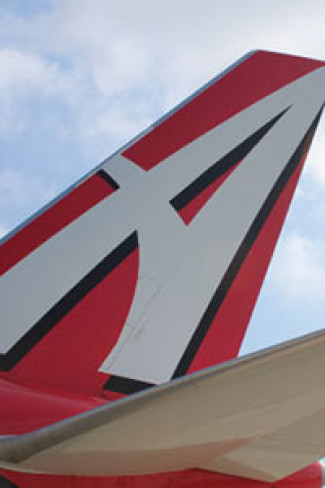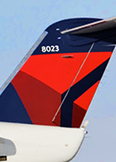When Northeast Airspace Meets Weather
Picture this: you're on the PHLBO 2 or DYLIN 4 arrival into Newark (essentially an overlay, except one's RNAV and has extra fixes at the end, but that doesn't matter for this scenario). You're approaching STEFE at 13,000' and there are some buildups in front of you. No problem, you just go 5 or 10 miles to the south and you can avoid the bumps, right?
Not so fast, buster. Your copilot squints out there to the right, and with that young 20/20 vision, he sees a bit of sunlight glinting off metal. What could that be? It's another jet on the KORRY 3 arrival to LGA,just 15 miles south of you and descending along a similar track to the northeast. And minimum separation since you're both talking to a center (though different sectors) is 5 miles. So they might get a little cranky if you wander too far to the south.
That's no big deal, you say. I can deviate a little to the north instead. And since your eyesight isn't quite as good as your copilot's, you fail to see more sunlight gleaming off to your left. That reflection's a G-IV on the JAIKE 2 arrival to Teterboro, about nine miles to your north, crossing ILENE at 13,000. And what's more, the JAIKE arrival is run by Philadelphia Approach, so Washington Center only owns airspace about six miles to the north of you. And since they need to stay 2-1/2 miles from adjacent airspace (that five-mile requirement cut in half),they can't approve a deviation too far to the north without coordinating something with another sector. That coordination takes time and attention away from scanning radar, so maybe they'll do it for you' maybe not.
So now you're getting impatient. Fine, you say, I can just descend underneath those buildups. My arrival says to cross SOMTO at 11,000 and DYLIN at 8,000. Surely, I can get 8,000 or so before DYLIN. Have you ever lain awake at night and wondered about why those fixes have crossing altitudes? Probably not, so go look at the Philadelphia arrivals. Up to the north, the SPUDS 1 and SLATT 3 arrivals (again,one's an RNAV overlay of the other) cross SPUDS intersection at 10,000. That 'cross SOMTO at 11,000' restriction keeps you in Washington Center's airspace with no effort. Now, SPUDS is north of the JAIKE arrival, and of course Philly Approach needs to descend their arrivals, so they probably wouldn't have traffic right under you at 10,000, but the airspace does belong to them, so again, center will have to call someone before they can approve your deviation.
Feeling a little surrounded and out of options? This scenario plays out over and over again around Northeast corridor. That KORRY 3 arrival to LGA has GATBY 1 turboprop arrivals to LGA and RUUTH 1 turboprop arrivals to EWR right underneath and following the same path. That JAIKE G-IV going to TEB? He crosses over top Philadelphia departures to MXE and PTW as well as the BOJID/BUNTS and SPUDS/SLATT arrivals to PHL and then probably ends up 7,000' or below by SBJ so he can go underneath the MILTON 3 arrivals to LGA.
Does your head hurt yet? These are just the arrivals coming into New York from the southwest. Let's talk about how it works when you leave Newark. Whenever you go from one controller's area of jurisdiction(AOJ) to another, there's a standard way for you to get there. No point in making this stuff up every day, with every new controller on position. There's way too much traffic for that. So if you're leaving New York or Philadelphia and going westbound, you'll go over one of several coordination fixes, depending on where you're trying to go. Those fixes start you out on a jet route, and usually that's where you transition from approach control to center. If you go to Denver,Chicago, LA, San Francisco, Seattle, anywhere to the west, you'll probably end up on one of these jet routes: J6, J80, J60, J64 or J36,at least initially. You'll climb out over or under arrival streams, get vectored around some in the approach control airspace to get whatever spacing is required (minimum of five because that's center radar spacing, although sometimes there are agreements to do 3 miles increasing to 5 miles), and then go direct to the first or second fix on your route and head off to center. All of this, most days, is awell-coordinated ballet, a beautiful thing.
But then comes the summer. All these jet routes are pretty far apart,maybe 15-40 miles apart by western NY and PA. So let's say you taxi out, knowing there's a line of thunderstorms extending from about ten miles north of Pittsburgh to Erie. That takes out your route off light, which starts out via ELIOT J60. So all those airplanes that are airborne right now on J60 are going south and north to avoid the weather. They deviate far enough, maybe 10-20 miles, and now they are impinging on another route. Cleveland Center might as well save themselves the trouble of rerouting everyone, approving deviations, and coordinating point-outs or handoffs with other sectors (see all that stuff they have to do?) and tell New York Center that J60 and J64(about 20 miles apart) are ground-stopped. So before you leave, you get rerouted onto J80.
Seems pretty simple and logical, right? In case you haven't figured it out yet, nothing's easy. This causes another problem. Picture a five-lane highway that's down to two lanes for construction. What happens? Everyone slows down to a crawl to merge from five to two, right? Well,since you can't fly the first 200 miles of your route slowed to 150 knots and New York Center has to take 5 lanes worth of traffic and put it all 5 miles in trail on 2 lanes worth of real estate, New York turns around and tells the approach controls that they need a miles in trail restriction, maybe 10 or 15 miles. On a bad day, it might be 20-30 miles.
Doesn't seem like that big of a deal, right? Just two or three times the separation? Except you've forgotten that instead of five lanes all five miles in trail, now we have two lanes fifteen miles in trail. So in a 20-mile long piece of airspace where we used to have 15-20 airplanes, now we can only have four. Of course, you're not all lined up next to each other, but it works the same way. If you're airplane#5 over a specific airway for departure, this doesn't affect you too much. If you figure tower provides this separation off the runway and(fuzzy math warning) that waiting for eight miles gives you about fifteen because the front aircraft is pulling away, then it's two to three minutes between departures for each airway. So where maybe you would've waited five minutes, now you're waiting ten or fifteen. Not that big of a deal. But if you're #40, that's 80 minutes from the #1 taking off until you get to go. And that assumes that the tower is launching one for your airway every two minutes. This ends up only worse, when instead of five lanes to two, we make it five lanes down to one.
This is when the airways are further away and further apart. What happens when the line of thunderstorms gets closer and is within thirty miles of the airport? Now the deviations are occurring when you're still with approach control. For starters, the closer the storms are, the more routes that are affected. You started out with ELIOT J60. But at ELIOT, J60 and J80 are the same airway. And just like the arrivals,going ten or fifteen miles out of your way is a big deal. It may mean that you're going towards someone else's airspace or conflicting with another arrival or departure stream. And maybe you can't get back over that fix that demarcates the boundary between approach and center. If that happens, then the controller has to work out a plan with the other one working a different stream of traffic. If the weather is staying in one place, they might be able to work out something that applies to a bunch of airplanes in a row. Maybe center agrees to take you on a specific heading, for example, instead of direct to ELIOT.
But how many people have we just involved? In this scenario, a minimum of three controllers, and a line of departures, to say nothing of the other lines of aircraft that you now have to miss. And we're asking for something out of the ordinary, something a little chaotic and unexpected. When we do that, when you're somewhere you're not supposed to be, it can be hard to predict where the conflicts will occur. And what works for a short-haul B737 may not work for a transcontinental A321 because of different climb rates. Some controllers, either because of skill level, temperament, or experience, may not be willing to work out a plan that involves so much nonstandard traffic flow. Their answer (and for them it may be the safest one) is to stop accepting departures over that fix. When the weather is all to the northwest of Newark, that might mean that all westbound or northwest-bound traffic will be ground-stopped until the storm moves through.
But let's say we have the controllers who are comfortable' no, who actually love chaos and thrive on it. They want to keep the flow going, help the businesswoman in the back of your plane who promised her eight-year-old she'd be home for his school play. To make that work,sometimes you'll be asked to fly through some weather. We'll line you up with a hole, since your peripheral weather radar isn't too good, and ask you what you think. I know, I know. You've had bad experiences with it. Sometimes you just get sent right through with no regard for your concern. But most of us will make some sort of effort to give you something you can live with, whether it gets communicated or not. Once you go through that hole in the weather, we play the game. We ask you how it was, and if you say light chop, we've got a green light to get everyone else through there. Game on!
Eventually,though, there will be the guy who doesn't want to go, even though the 15 airplanes before him said occasional light chop, moderate rain. And when that happens, the game is over. Yes, we'll work out something just for him. He has to get there somehow. But after him, no one else departs to go that way. Ground-stopped. Game over. And everyone else on the ground waits for the weather to move on by.
Am I saying you should fly through the weather? Of course not! What I'm looking for is a little patience and understanding' maybe a little willingness to at least take a look at something. Maybe it doesn't help you that much, but it might make the world of difference to someone behind you, still waiting on the ground. Or maybe you should move to Big Sky country. This has been a commercial presentation for the Montana Tourism Board.
-

Piedmont Airlines 10/16/2024
-

ABX Air 10/11/2024
-

Allegiant Air 09/25/2024
-

Premier Private Jets 09/25/2024
-

Endeavor Air 09/25/2024
 AIRLINE PILOT CENTRAL
AIRLINE PILOT CENTRAL